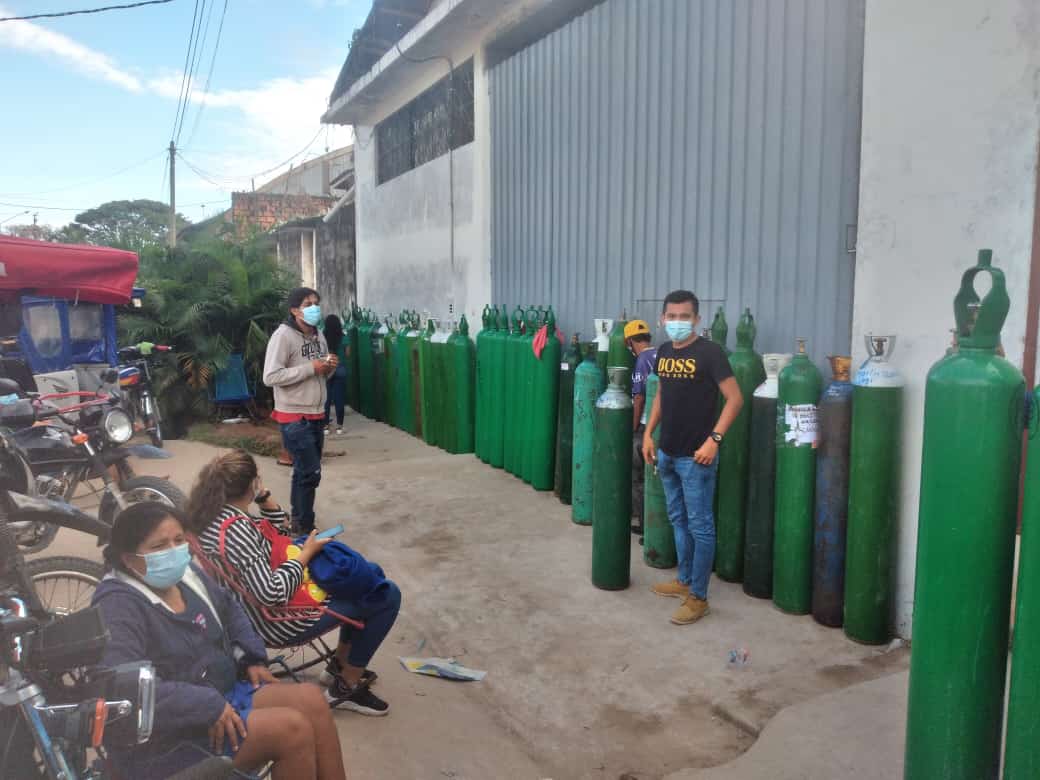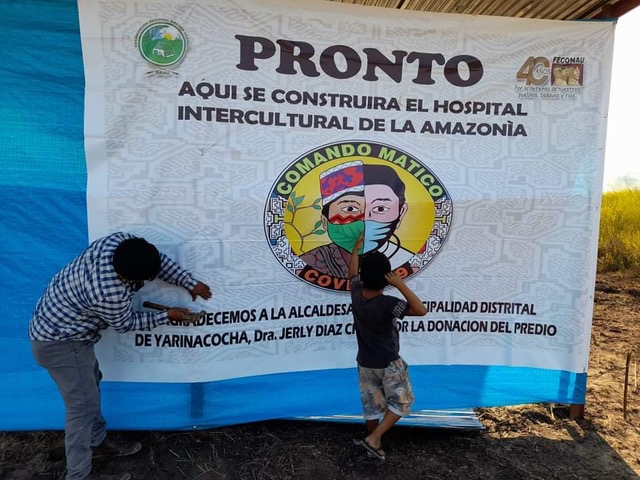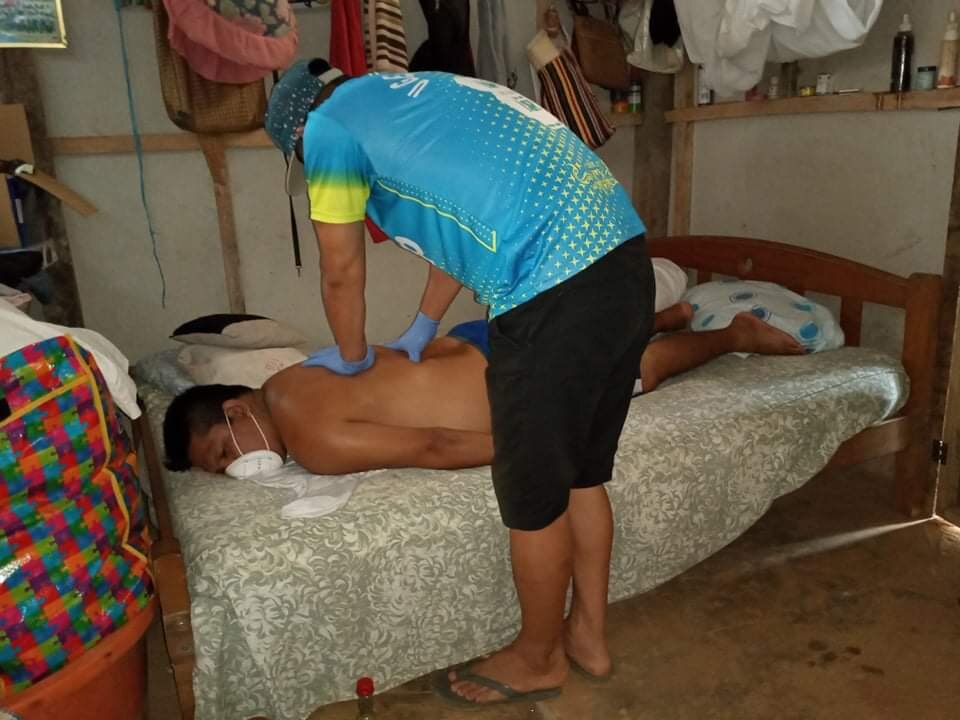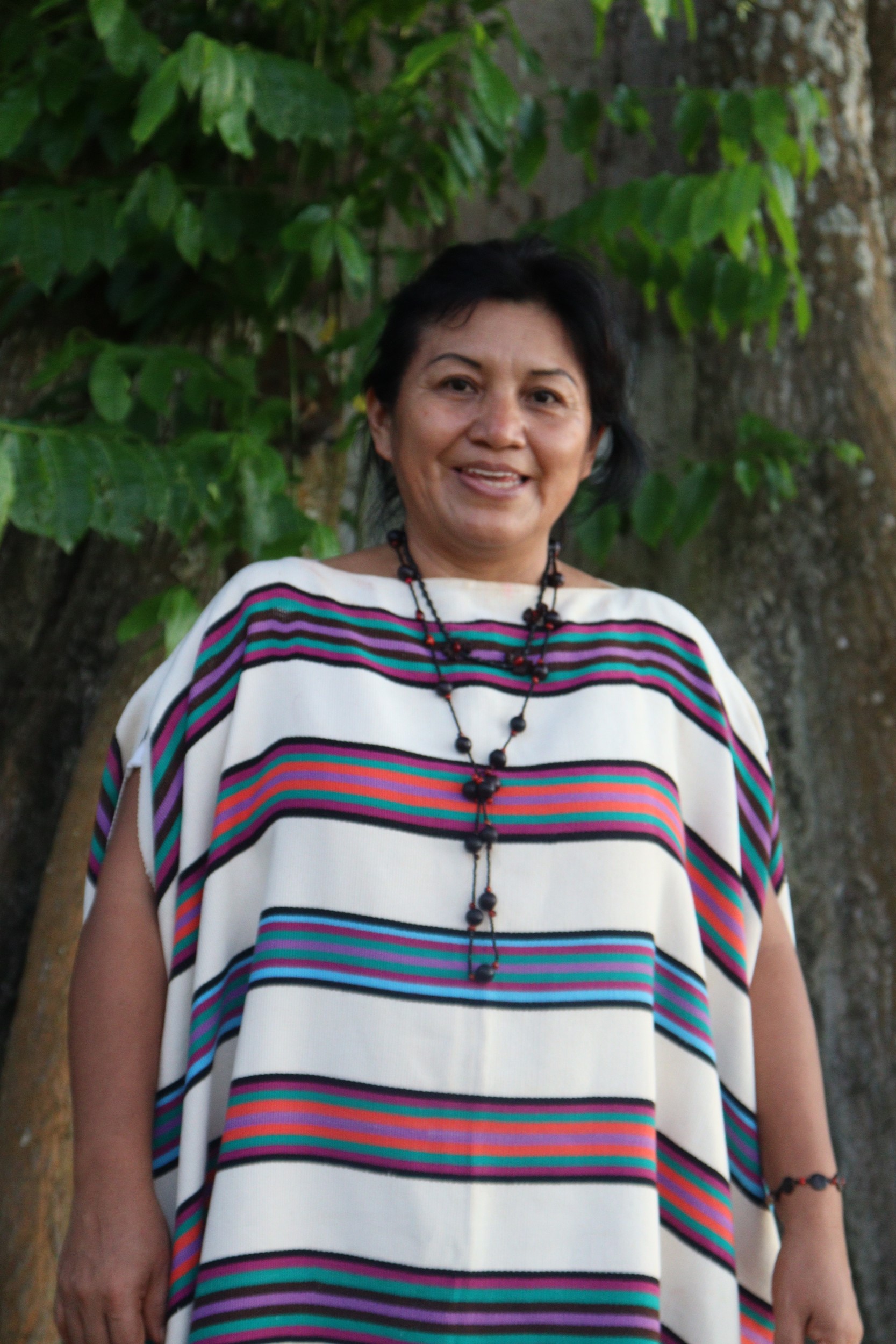Six hours from the closest hospital is San Francisco, a village of 45 families. There, Roger Lopez had been healing Shipibo women, men, and children as well as visitors from around the world for more than three decades. He and his mother were well-known botanists who helped a great number recover from diverse illnesses with herbal preparations. Roger supported a school for orphans that gave them formal schooling and trained them in Shipibo botanical knowledge and spiritual traditions. After fighting Covid-19 for weeks in a public hospital, he went back to Nii Juinti, to his plantation of diverse lianas and trees. Recovering from Covid sequelae proved impossible and the disease took his life in March 2021. With him, leadership, vital knowledge, and practices of care died.
We are only beginning to grasp the overwhelming impact of Covid-19 on the Amazon Basin, as vaccinations are now taking place among Indigenous communities at a reasonable pace. The loss of leadership and knowledge, significant waves of return migration to rural communities, and shifts in their economic activities will have long-lasting consequences for Indigenous peoples.
Peru, which has the second largest Amazonian territory, is one of the hardest-hit countries in the world. In 2020, the country had the most severe Covid-19 outbreak worldwide and, in the first quarter of 2021, one of the worst death rates per million inhabitants. The pandemic has revealed the Peruvian health system’s weaknesses,1Jesús Neyra-León et al., “The Impact of Covid-19 in the Healthcare Workforce in Peru,” Journal of Public Health Policy 42 (2021): 182–184. which are even more acute in Amazonian regions. How are Indigenous peoples confronting this harsh reality? The Ucayali Region can give us an example. By conducting a collaborative research with Indigenous leadership in the region, we highlight the tools that are making a difference: political advocacy, the scaling-up of self-organized practices of care, and a wide sharing of knowledge of traditional medicine. Here we discuss how the language of “resilience” can both describe and obscure profound inequalities that Indigenous peoples faced during this global crisis.
Ucayali’s Covid-19 situation
Ucayali is the second most ethnically diverse region in the country. Indigenous families from the Ucayali Region are dealing with multiple challenges when confronting the pandemic. Before Covid-19 reached the Amazon, infectious diseases, such as HIV, malaria, and dengue, were notoriously prevalent. In fact, a significant dengue outbreak hit Ucayali right before Covid-19. Besides direct health factors, Indigenous families lack access to basic public services for a healthy life, including access to safe drinking water and proper housing in urban contexts. For instance, in Purus, the province with the highest concentration of Indigenous peoples, just two out of 100 people have access to clean water, according to data gathered by the Peruvian Ministry of Development and Social Inclusion.

A culturally insensitive health system, which was particularly ill-equipped to care for Indigenous peoples, left them behind. As Oseas Barbaran, the president of the Confederation of Amazonian Nationalities of Peru (CONAP), told us: “There has been no medication available in the communities. Even technicians and nurses who worked in different districts [of Ucayali] went back to Lima because they could no longer bear it. They had no supplies to continue caring for their patients.”
According to Willy Lora, head of Ucayali’s Regional Health Administration (DIRESA-Ucayali), there were just 32 hospital beds and four mechanical ventilators in the Covid-19 unit of the Amazonian Hospital of Yarinacocha, the biggest of the region, during the first five months of the pandemic. Unsurprisingly, between May and June 2020, Ucayali had the most rapidly growing curve of Covid-19 cases in the country, which caused the death of several Indigenous leaders, such as Silvio Valles. Silvio, the prominent mayor of a rural Shipibo municipality, died in this hospital because of medical oxygen shortages. This situation fomented distrust in the health system among Indigenous populations who, since then, have avoided hospital visits and rejected hospitalization.
Although experience in dealing with the pandemic allowed other health systems to adapt, intercultural health approaches to Covid-19 for the Amazonian regions did not take shape. Cristina Bejarano, a member of Ucayali’s health network, pointed out that the Peruvian national health system applied the same Covid-19 strategy in both big cities and Amazonian rural communities. It privileged strengthening the leading city hospitals and dismissed equipping community health centers. Many Indigenous peoples had to navigate intricate jungle rivers for several days to reach care at an urban hospital. On top of this, the strategic airlift of critically ill patients and the rapid provision of medical equipment wasn’t sustained.
The only carers who remained on the front line were community members, such as health promoters and traditional medicine providers, making community health response even more essential. In Ucayali, Indigenous leaders activated community epidemiological surveillance by taking notes on the number of people reporting symptoms and communicating them to the nearest health centers. They also set “self-defense” strategies by avoiding family visits among different native communities to prevent contagion. In this context, several Indigenous organizations decided to publicly denounce the situation and self-organized to cope with Covid-19.
Indigenous organizations’ political advocacy
A sense of urgency and despair grew among the leadership, as their people were dying and no one considered their involvement essential in what was a rather precarious early national state response. Thus, Indigenous organizations mobilized a wide range of advocacy strategies to influence Covid-19 action plans for their territories. Ronald Suarez, a representative of the Shipibo Conibo Xetebo Council (Coshikox) explained:
“We had to resort to protest and public action because every day we had more and more deaths—the elderly, our friends, and relatives. It was a state of hopelessness. We needed someone to help us, be our spokesperson, our intermediary with the government.”
Given this situation, Indigenous peoples protested in front of government offices, demanding their right to participate in the Covid-19 response planning. Coshikox, the Ashaninka Federation of Lower Urubamba (FABU), the Regional Organization of AIDESEP Ucayali (ORAU), the Interethnic Association for the Development of the Peruvian Rainforest (AIDESEP), the CONAP, and the National Organization of Indigenous Women of Peru (ONAMIAP) were among the organizations that made public accusations or statements, expecting a response from the national government and particularly the Health and Cultural Ministries. They demanded the provision of a specific budget, as well as that contingency and prevention plans to tackle Covid-19 should be adapted to Amazonian Indigenous communities.

Ucayali’s Regional Office for Indigenous Peoples, Indigenous organizations, and other stakeholders gathered to propose a Covid-19 plan that would reflect the actual needs of Indigenous peoples and a well-thought-out intervention strategy. The plan focused on strengthening healthcare at community and local levels in native communities; the promotion of nutritional food security; and a communication plan with an intercultural approach. Health for Indigenous peoples is conceived as “being and feeling good with the environment that surrounds us,” which implies “having good relations with all members of the community and good balance with nature.”2Ismael Vega et al., Aportes para la construcción de una salud intercultural en el ámbito amazónico (Lima, Peru: Mesa de Concertación para la Lucha contra la Pobreza, 2021). In other words, if there is no respect for nature there is no viable pathways for healthy human communities. Improving community health means improving the collective balance that largely supersedes the individual human body and includes a living collectivity of humans and nonhumans.
In May 2020, some months after the plan was agreed to, the Peruvian government set aside five million soles (or around US$1.2 million) for an intercultural strategy and included Indigenous populations in the universal family stimulus program. Hence, the design and approval of the Plan to Address the Pandemic of Covid-19 in Indigenous communities was an achievement, but the state did not put into practice a very significant part of what was agreed. No campaigns and health personnel were deployed to the communities. Facing this disappointment, Indigenous peoples carried out many of these actions with their own resources.
Sharing traditional medicine findings and practices of care
Self-organized initiatives to care for and heal people with Covid-19 grew all over Ucayali. Indigenous youth from the Shipibo peoples created the “Comando Matico Covid-19,” an alternative community-based healing center where they provided conventional medicine along with traditional medicine by using plants, herbs, and ancestral techniques. Comando Matico has applied and broadly shared healing techniques with other self-organized community health centers. “We have sent Shipibo doctors and nurses to provide medicines and advise people, not only with scientific Western medicine but also to guide them to use our plants,” said Ronald Suarez from Coshikox. Taking a holistic view both of the disease and of the human body and also performing shamanic rituals to confront the animated agents of illness, they used heated water vapors and hot baths with hot stones, healing roots, and sacred plants, such as matico (Piper aduncum), “garlic sacha” (Mansoa alliacea), and mucura (Petiveria alliacea). They also recommended “stomach cleansing” to eliminate “parasitic infections” and hydration.

Experimentation on new uses and treatments with traditional plants (such as matico) based on their properties and previous applications to deal with Covid-like symptoms (such as cough, body pain, and pneumonia) became a widespread practice in the Amazon Basin. Families rediscovered traditional medicine’s potential and recovered ancestral Indigenous wisdom. Susana Silva of FABU said: “Covid-19 has made us stop looking at our medicinal plants as something useless. It has added more value to our knowledge and now plants are being used by the communities’ sisters and brothers, saving the lives of many of us.”
Nowadays, Indigenous organizations are demanding traditional medicine be included in the practices of every Amazonian community health center, alongside Western medicine. Susana Silva continued:
“Our proposal is to insert the worldview of medicinal plant use into regional and national budgets, by including traditional medicine in all health centers at the Amazon— and why not nationally? The plants are not harmful. We need our brothers to be healthy, without chemicals, which have only led to worsening diseases and other rare diseases that have appeared Plants are natural healers; they really cure you—we want an intercultural health policy.”
Lockdown prevented communities from selling their products and acquiring basic foodstuffs, restricting their diet. In these circumstances, Indigenous peoples decided to reclaim their traditional agricultural practices. Indigenous organizations promoted integrative chacras3Robin R. Sears et al., “Farm-forestry in the Peruvian Amazon and the Feasibility of its Regulation through Forest Policy Reform,” Forest Policy and Economics 87 (2018): 49–58. with an organic, family-oriented, and self-subsistence approach through family gardens, to avoid large gatherings of the community and privilege spending time in communal forests. Changes in the community’s diet, such as favoring fresh products with little salt or sugar and changing the way to store masato, were also widely accepted. The emphasis was on the role of good nutrition to help withstand the disease.
Local leaders have promoted the reclamation of diets based on produce native to the area: “Our brothers should be well-fed with the sachapapa, the dale dale, the worms of the bush, the little fish, the mushrooms, the animals, the birds, free-range chickens and eggs and by raising pigs and all kinds of edible animals. Then the brothers’ immunity systems and defenses will be raised,” remarked Susana Silva.

Indigenous peoples’ health beyond a biomedical approach
As the experience of Indigenous peoples from Ucayali shows, self-organization is a path to strengthen collective agency in the face of adversity. Indigenous organizations went from lobbying for changes at the regional and national level to change the state strategy to ensure communal healthcare. The changes were slow and insufficient, so they worked as a network, proactively translating and broadcasting messages on Covid-19 prevention into Indigenous languages in community radio stations. They reactivated epidemiological surveillance (by self-isolation and coordinated intercommunal monitoring), they shared traditional botanical therapeutic techniques and effective healthcare practices that have a profound history on the management of infectious diseases for each of their peoples. However, framing these proactive responses to Covid-19 as the inherent resilience of Indigenous peoples can be misleading and even dangerous. Considering the lack of public services throughout the Amazon Basin, overstating Indigenous peoples’ self-reliance is a subtle way to abandon them to be resilient. We can already observe that, as they were praised for their agency, they did not receive effective public support. Emergency support and evacuation of critical cases was desperately needed but absent. We must acknowledge that these communities have faced shocking public indifference compelling them to act independently. This is particularly alarming as, in this case, the lack of response is not the result of a lack of budget—which was actually allocated fairly early—but of the state’s inability to spend resources swiftly to save lives through meaningful actions.
In contexts such as the Amazon Basin, an intercultural approach to healthcare implies that health services not only respect Indigenous medical practices but enables joint and complementary interactions between biomedical and Indigenous medical approaches to prevent and treat healthcare problems.4Doreen Montag et al., “Healthcare of Indigenous Amazonian Peoples in Response to Covid-19: Marginality, Discrimination and Revaluation of Ancestral Knowledge in Ucayali, Peru,” BMJ Global Health 6, no. 1 (2021). Although Indigenous organizations’ initiative and self-organization identified and responded to crucial needs, it remains marginal and, more importantly, unsupported by the national health system. However, it is never late to move beyond ineffective structures and engage in fruitful collaborations that can actually protect all peoples in the Amazon.
Banner photo: David Swinney/Flickr.














